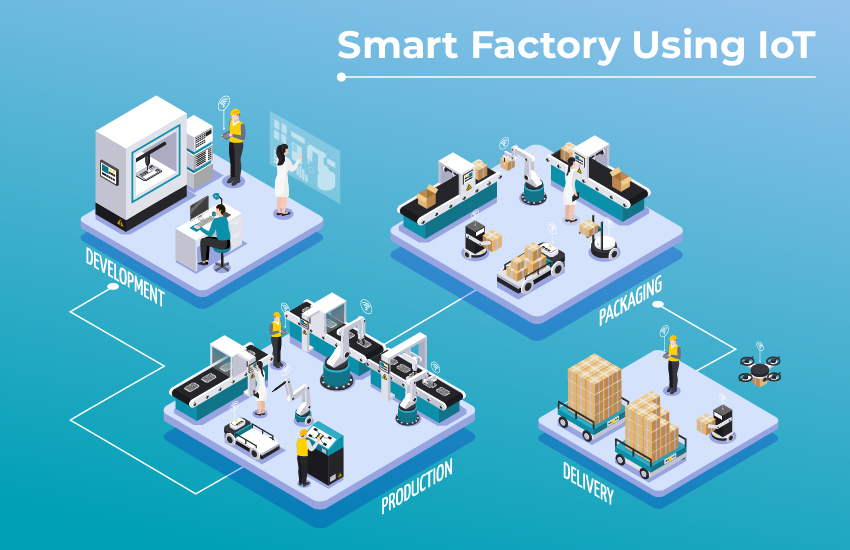
Industry 4.0 is the 4th industrial revolution. This includes smart factories as a key element in order to enhance efficiency in part production.
We have witnessed or are aware of the first three digital revolutions. Thus, we can say that the first half of this digital revolution was about using machines to connect people which allowed them to share ideas, memories, experiences, etc. across the globe.
In the second half of the industrial revolution, machines will talk to each other, using cloud-connected Internet of Things (IoT) devices to help automate the creation and delivery of products.
A smart factory is Industry 4.0’s highly automated manufacturing facility that utilizes advanced technologies, such as the Internet of Things (IoT), artificial intelligence (AI), and robotics, etc. to optimize its operations and improve its productivity, quality, and efficiency.
Smart factories use advanced digital technologies to improve operational efficiency and productivity.
Smart factories are connected factories which rely on advanced technologies such as IoT, artificial intelligence, and robotics. So that it can optimize production processes and enhance operational efficiency. Smart factories are thus highly automated.
The smart factory connects digital and physical systems with the Internet of Things. These systems can consist of wireless connections, sensors, and data collection programs.
In a smart factory, machines, and equipment are interconnected and communicate with each other using advanced technologies such as IoT, AI, etc. These smart factories have a central control system to enable real-time monitoring, analysis, and decision-making. Due to this, manufacturers can optimize their processes, decrease environmental pollution, and increase flexibility to respond quickly to changing market demands.
In order to drive the digital transformation of manufacturing, and enable companies to operate more efficiently, cost-effectively, and sustainably, the application of IoT in smart factories is recently developed.
It has become the need of today to introduce and implement IoT technology in your factory if you want fast and quality production.
If you adapt to the Industrial Internet of Things, it can make you one of the top manufacturers and get more customers.
So, if you want to adopt IoT technology in your factory, you must collect more and more information about it. There are many best IOT training courses available in the market. Choose any one IOT online course and get started!
Let us look at the Advantages of IoT in the below sections!
The key principles behind the Smart Factory are connectivity besides data analysis and diagnostics. This leads to fewer shutdowns, improved processes, and optimized facilities.
A smart factory is based on the latest technologies and connectivity to drive improvements to processes.
Technologies such as IoT and artificial intelligence create a more responsive yet predictive manufacturing environment that makes the most of the available resources to deliver cost-effective and efficient manufacturing.

There are a wide variety of different technologies related to the fourth industrial revolution (Industry 4.0) that smart factories use to optimize smart manufacturing processes.
These technologies include:-
Sensors, Big Data Analytics, Cloud Computing, Virtual and augmented reality, Digital Twins, etc.
In a Smart Factory, IoT technology is used to connect various devices, machines, and sensors to a central network. This optimizes the manufacturing process and reduces downtime too.
A Smart Factory is nothing but the industry 4.0 version of the manufacturing process, which is more effective, adaptable, and sustainable. This helps companies to maintain their competitiveness in complex marketing conditions.
In a smart factory, devices, machines, and systems that are interconnected, communicate with each other using IoT, which makes production processes more efficient, easier, flexible, and automated. Thus, to monitor and control various aspects of the production process, IoT devices can be used in smart factories.
IoT devices can help manufacturers to save money in part production processes, by optimizing processes and reducing downtime in smart factories.
IoT sensors can also detect and alert workers so that they identify potential safety hazards and prevent accidents and injuries for workers.
In smart factories, IoT sensors can be applied to monitor the entire manufacturing process from start to end, that is, from raw materials to finished products. This provides manufacturers with real-time data on production efficiency and quality which enables them to make data-driven decisions to optimize their processes and improve their products.
IoT sensors can predict when machines will require maintenance, this allows for proactive maintenance to be performed before breakdowns occur.
IoT sensors can also be used to monitor the factory environment so that they can detect potential safety hazards or security breaches. This can ensure that workers are safe and that valuable equipment and assets are protected.
Manufacturers can make informed decisions about production and distribution using IoT, as IoT can track inventory and manage the supply chain. This can reduce downtime as well as save time and money for the manufacturers.
Manufacturers can increase productivity, enhance quality control, and improve efficiency using the IoT by the use of the power of connected devices using energy-saving methods, sensors, and software.
In order to reduce unplanned downtime by identifying potential equipment failures before they occur in machines and production equipment, predictive maintenance is used. This type of maintenance is another application of IoT in smart factories. Using this, factory managers can provide maintenance schedules and minimize downtime.
Among other applications, IoT can be used for inventory management, asset tracking, and energy management too.
Smart factories using IoT devices create an environment that is connected and automated and it enables real-time monitoring of manufacturing processes along with their analysis and control.
While the core principles of IoT in smart factories are well-established, the possibilities for further innovation are vast. Some emerging applications include:
Digital Twins: Creating virtual replicas of physical assets enables predictive maintenance, optimization, and design improvements.
Edge Computing: Bringing data processing closer to the origin reduces delays and improves instant decision-making.
Artificial Intelligence and Machine Learning: Analyzing vast amounts of data to identify patterns, trends, and anomalies, leading to smarter operations.
Cybersecurity: Protecting sensitive data and ensuring the integrity of the entire system is paramount in the age of interconnected devices.
While the benefits of smart factories are undeniable, there are challenges to address:
Initial Investment: Implementing IoT technologies can be costly, requiring significant upfront investment.
Data Security and Privacy: Protecting sensitive data is crucial, especially in industries with stringent regulations.
Skill Gap: A shortage of skilled workers with expertise in IoT, AI, and cybersecurity can hinder adoption.
Smart factories, powered by IoT, are the future of manufacturing. Organizations would wisely take advantage of smart technology to improve manufacturing processes, with all the above benefits already in place.
The use of the IoT (Internet of Things) technology, along with data analytics and sensors, can make a smart factory an active part of the move towards Industry 4.0. It shows improvements across the entire production process.
Smart factory using IoT will allow manufacturers to mass-produce more goods with fewer defects and at lower costs. And as we move toward a personalized, data-driven future they will increasingly be used to create products customized for each individual.
At Modelcam Technologies, we provide the best IOT training in the market! Among many industrial IOT courses, we provide the best IOT online course which will give you the best training in the market about IOT technology.
©Copyright 2025. All rights reserved by Modelcam Technologies Private Limited PUNE.